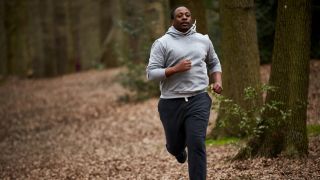Does Running Burn Fat? Yes, And You Can Maximise How Much Fat You Burn With This Trick
It sure does, but how does running burn fat and what type of run can maximise fat loss? We spoke to a performance physiologist to get the answers

Running, like all exercise, can spur your body to burn fat, but fat isn’t the only fuel available to power your movement and it’s rarely your body’s first choice. However, running allows you to work at an intensity that maximises the amount of fat you burn. And the good news is that going full pelt won’t necessarily yield the best fat-loss results.
However, if you’re running for weight loss, then as well as burning fat you want to burn calories too, and a higher-intensity workout will help running burn more calories. If you’re confused, we don’t blame you – we were too. So we turned to Steven Harris, performance physiologist at Loughborough University, to explain the key concepts of FatMax training and fasted running.
How does running burn fat?
When we talk about burning fat, we’re really talking about fat oxidation. This is an aerobic process, where oxygen is used to break down stored fat to provide fuel for your movement.
“Fat oxidation will peak at a moderate running intensity,” says Harris, “before reducing as you run faster.” When you’re really exerting yourself, your body will start to draw more of its energy from carbohydrate-based sources (which is why serious runners racing in a marathon consume carbs in the form of running gels and sports drinks mid-run – if they run out of fuel they hit the dreaded wall and bonk).
There is a precise intensity that results in the greatest fat oxidation, called your FatMax, but calculating it for an individual really requires lab tests – beyond the means of most. Our expert guide to FatMax training explains more, but a straightforward takeaway is that running at an easy pace is a smart way to make sure running is burning fat.
As well as the intensity of your run, what you eat and when can affect how much fat you burn while running. According to Harris, if you’ve eaten a high-carb snack before a moderate-intensity run, your body will break this down into fuel before turning to other stored sources of energy.
Conversely, if you haven’t eaten anything before your session, your body will start to metabolise fat quite quickly. However, before you decide to wait until you’re famished to go for a run, Harris recommends using this fasted approach sparingly.
Get the Coach Newsletter
Sign up for workout ideas, training advice, reviews of the latest gear and more.
“Training [while] fasted makes running at higher intensity more challenging, as your body’s ability becomes limited by the speed that your aerobic energy systems can provide energy,” says Harris. “When you are targeting a high-intensity or interval session, it is very important to start well fuelled.”
For a more detailed exploration of the potential benefits and risks to help you decide if it’s right for you, as well as how best to do it, read our in-depth guide to fasted running.

Using running to create a calorie deficit
So far, so straightforward. To burn fat by running, you need to take it easy. Well, to a degree. Another equally valid approach to fat loss is to create a calorie deficit – expending more energy than you consume. According to Harris, maintaining a calorie deficit can help contribute to the reduction of non-functional body mass, and increasing the intensity of your workout is one way to expend more energy.
“FatMax occurs at a relatively low intensity,” says Harris. “A higher-intensity run may help you burn more calories quicker and therefore have a greater impact on your energy balance.”
Both approaches have their merits. Moderate-intensity runs will allow you to burn a higher proportion of fat and you can maintain this type of workout for a longer period, but if you’re squeezed for time and need to do a shorter workout, then a high-intensity session will expend a greater amount of energy, which will lead to a bigger calorie deficit.
To remove the burden of decision-making from you, we recommend using a running training plan. We have free plans for all levels and distances, and once you’ve worked through a couch to 5K plan, any good plan will vary the types of run so you’ll be doing some workouts around your FatMax and some at higher intensities every week. Most importantly, the weekly mileage increases gradually to reduce the risk of you suffering an injury.
Steven Harris studied sport and exercise science at the University of Bath before completing a master’s degree in physiology at Loughborough University, during which time he aided the university’s cycling team. On his return to Loughborough as an academic, Steven aided the squad with extensive physiology testing and implementation of tailored physiology training. He also has a wide base of experience working across a range of sports from rugby to skeleton bobsleigh.
Sarah is a freelance journalist who writes about fitness and wellbeing for the BBC, Woman&Home and Tech Radar. During lockdown she found her love of running outside again and now attempts to run around 50 miles a month.

